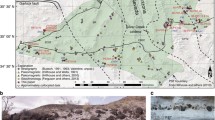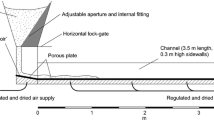Abstract
We conducted laboratory experiments on dam-break flows of sub-250-µm volcanic ash, generated by the release of gas-fluidized and variably non-expanded to expanded (up to 35%) beds, in order to gain insights into the internal kinematics of pyroclastic flows. The flows were typically several cm thick and had frontal speeds of up to ∼2 m s−1. High-speed videos taken through the transparent sidewall of the 3-m-long channel were analyzed with a particle-tracking algorithm, providing a spatial and temporal description of transport and sedimentation. The flows deposited progressively as they traveled down the flume, being consumed by sedimentation until they ran out of volume. Deposition commenced 5–20 cm rearward of the flow front and (for a given expansion) proceeded at a rate independent of distance from the lock gate. Deposit aggradation velocities were equal to those inferred beneath quasi-static bed collapse tests of the same ash at the same initial expansions, implying that shear rates of up to ∼300 s−1 have no measurable effect on aggradation rate. The initially non-expanded (and just fluidized) flow deposited progressively at a rate indicative of an expansion of a few percent, perhaps due to shear-induced Reynolds dilation during initial slumping. The fronts of the flows slid across the flume floor on very thin basal shear layers, but once deposition commenced a no-slip condition was established at the depositional interface. Within the flows, the trajectory of the constituent particles was linear and sub-horizontal. The velocities of the particles increased with height above the depositional interface, reached a maximum, then declined slightly towards the flow surface, perhaps due to air drag. At a given location, the velocity profiles were translated upwards as the deposit aggraded. The results show that even cm-thin, poorly expanded flows of ash deposit progressively, as inferred for many pyroclastic flows. The change from (frontal) slip to (rearward) no-slip conditions at the bases of the laboratory flows are qualitatively consistent with some textural features of pyroclastic flow deposits.











Similar content being viewed by others
References
Branney MJ, Kokelaar MJ (1992) A reappraisal of ignimbrite emplacement: progressive aggradation and changes from particulate to non-particulate flow during emplacement of high-grade ignimbrite. Bull Volcanol 54:504–520
Branney MJ, Kokelaar P (2002) Pyroclastic density currents and the sedimentation of ignimbrites. Geol Soc Lond Mem 27:1–152
Buesch DC (1992) Incorporation and redistribution of locally derived lithic fragments within a pyroclastic flow. Geol Soc Am Bull 104:1193–1207
Cole PD, Calder ES, Sparks RSJ, Clarke AB, Druitt TH, Young SR, Herd RA, Harford CL, Norton GE (2002) Deposits from dome-collapse and fountain-collapse pyroclastic flows at Soufrière Hills Volcano, Montserrat. Geol Soc Lond Mem 21:231–263
Corpetti T, Heitz D, Arroyo G, Ménin E, Santa-Cruz A (2006) Fluid experimental flow estimation based on an optical-flow scheme. Exp Fluids 40:80–97
Davies R, Kaye B (1971) Experimental investigation into the settling behaviour of suspensions. Powder Technol 5:61–68
Denlinger RP, Iverson RM (2004) Granular avalanches across irregular three-dimensional terrain: 1. Theory and computation. J Geophys Res 109:F01014. doi:10.1029/2003JF000085
Doyle E, Huppert HE, Lube G, Mader H, Sparks RSJ (2007) Static and flowing regions in granular collapses down channels: insights from a sedimenting shallow water model. Phys Fluids 19:10–21
Druitt TH (1995) Settling behaviour of concentrated, poorly sorted dispersions and some volcanological applications. J Volcanol Geotherm Res 65:27–39
Druitt TH (1998) Pyroclastic density currents. Geol Soc Lond Spec Pub 145:145–182
Druitt TH, Avard G, Bruni G, Lettieri P, Maes F (2007) Gas retention in fine-grained pyroclastic flow materials at high temperatures. Bull Volcanol 69:881–901
Eames I, Gilbertson MA (2000) Aerated granular flow over a horizontal rigid surface. J Fluid Mech 424:169–195
Forterre Y, Pouliquen O (2008) Flows of dense granular media. Ann Rev Fluid Mech 40:1–24
Freundt A, Bursik MI (2001) Pyroclastic flow transport mechanisms. Devel Volcanol 4:173–245
Geldart D (1973) Types of gas fluidization. Powder Technol 7:285–292
GDR MiDi (2004) On dense granular flows. Eur Phys J E14:341–365
Gilbertson MA, Jessop DE, Hogg AJ (2008) The effects of gas flow on granular currents. Phil Trans Roy Soc Lond A366:2191–2203
Girolami L, Druitt TH, Roche O, Khrabrykh Z (2008) Propagation and hindered settling of laboratory ash flows. J Geophys Res 113:B02202. doi:10.1029/2007JB005074
Hoblitt RP (1986) Obsevations of the eruptions of July 22 and August 7 1980 at Mount St Helens, Washington. US Geol Survey Prof Paper 1335:1–44
Horn B, Schunck B (1981) Determining optical flow. Art Int 17:185–203
Hughes SR, Druitt TH (1998) Particle fabric in a small, type-2 ignimbrite flow unit (Laacher See, Germany) and implications for emplacement dynamics. Bull Volcanol 60:125–136
Hutter K, Wang Y, Pudasaini P (2005) The Savage-Hutter avalanche model: how far can it be pushed? Phil Trans Roy Soc Lond A363:1507–1528
Iverson RM, Denlinger RP (2001) Flow of variably fluidized granular masses across three-dimensional terrain 1. Coulomb mixture theory. J Geophys Res 106:537–552
Iverson RM, Vallance JW (2001) New views of granular mass flows. Geology 29:115–118
Knight MD, Walker GPL, Ellwood BB, Diehl JF (1986) Stratigraphy, palaeomagnetism, and magnetic fabrics of the Toba Tuffs: constraints on the sources and eruptive styles. J Geophys Res 91:10355–10382
Lettieri P, Yates J, Newton D (2000) The influence of interparticle forces on the fluidization behavior of some industrial materials at high temperature. Powder Technol 110:117–127
Levine AH, Kieffer SW (1991) Hydraulics of the August 7 1980 pyroclastic flow at Mount St Helens, Washinton. Geology 19:1121–1124
Lockett MJ, Al-Habbooby HM (1974) Relative particle velocities in two-species settling. Powder Technol 10:67–71
Pittari A, Cas RAF (2004) Sole marks at the base of the late Pleistocene Abrigo Ignimbrite, Tenerife: implications for transport and depositional processes at the base of pyroclastic flows. Bull Volcanol 66:356–363
Potter DB, Oberthal CM (1987) Vent sites and flow directions of the Otowi ash flows (lower Bandelier Tuff), New Mexico. Geol Soc Am Bull 98:66–76
Rhodes MJ (1998) Introduction to particle technology. Wiley, New York
Roche O, Gilbertson MA, Phillips JC, Sparks RSJ (2004) Experimental study of gas-fluidized granular flows with implications for pyroclastic flows emplacement. J Geophys Res 109:B10201. doi:10.1029/2003JB002916
Roche O, Gilbertson MA, Phillips JC, Sparks RSJ (2005) Inviscid behaviour of fines-rich pyroclastic flows inferred from experiments on gas-particle mixtures. Earth Planet Sci Lett 240:401–414
Roche O, Montserrat S, Niño Y, Tamburrino A (2008) Experimental observations of water-like behavior of initially fluidized, unsteady dense granular flows and their relevance for the propagation of pyroclastic flows. J Geophys Res 113:B12203. doi:10.1029/2008JB005664
Roche O, Montserrat S, Niño Y, Tamburrino A (2010) Pore fluid pressure and internal kinematics of gravitational laboratory air-particle flows: insights into the emplacement dynamics of pyroclastic flows. J Geophys Res, in press
Rowley PD, Kuntz MA, Macleod NS (1982) Pyroclastic-flow deposits. US Geol Surv Prof Paper 1250:489–512
Sparks RSJ (1976) Grain size variations in ignimbrites and implications for the transport of pyroclastic flows. Sedimentology 23:147–188
Sparks RSJ, Gardeweg MC, Calder ES, Matthews SJ (1997) Erosion by pyroclastic flows on Lascar Volcano, Chile. Bull Volcanol 58:557–565
Suzuki K, Ui T (1982) Grain orientation and depositional ramps as flow direction indicators of a large-scale pyroclastic flow deposit in Japan. Geology 10:429–432
Suzuki-Kamata K (1988) The ground layer of Ata pyroclastic flow deposit, southwestern Japan—evidence for the capture of lithic fragments. Bull Volcanol 50:119–129
Takahashi T, Tsujimoto H (2000) A mechanical model for Merapi-type pyroclastic flow. J Volcanol Geotherm Res 98:91–115
Wilson CJN (1980) The role of fluidization in the emplacement of pyroclastic flows: an experimental approach. J Volcanol Geotherm Res 8:231–249
Wilson CJN (1986) Pyroclastic flows and ignimbrites. Sci Prog Oxford 70:171–207
Acknowledgments
We thank J.L. Fruquière and G. Carazzo for technical assistance throughout the experiments involving the high-speed video camera. The paper benefited from useful reviews by P. Dellino and J. Dufek.
Author information
Authors and Affiliations
Corresponding author
Additional information
Editorial responsibility: R. Cioni
Rights and permissions
About this article
Cite this article
Girolami, L., Roche, O., Druitt, T.H. et al. Particle velocity fields and depositional processes in laboratory ash flows, with implications for the sedimentation of dense pyroclastic flows. Bull Volcanol 72, 747–759 (2010). https://doi.org/10.1007/s00445-010-0356-9
Received:
Accepted:
Published:
Issue Date:
DOI: https://doi.org/10.1007/s00445-010-0356-9




